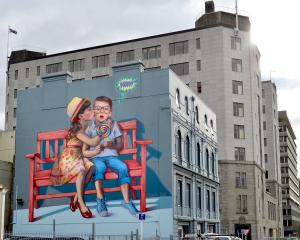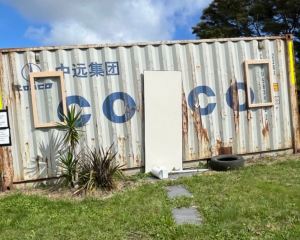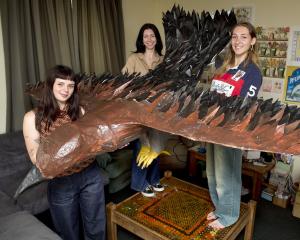Two New Zealand choreographers and a dancer from Bosnia had one thing in common when approaching the Royal New Zealand Ballet's production of Salute, Remember World War 1: a feeling of trepidation, reports Rebecca Fox
When he was 5, Damir Emric was fleeing his war-torn home country.
Two decades later, faced with performing in a war-themed production for the Royal New Zealand Ballet those memories again came to the surface.
''It still feels like it hit home for me, it means such a lot this Salute programme,'' Emric (27) said.
''It brings memories back in a bad way but it's also very nice to know we have come above it and survived it.''
Emric's family fled from Bosnia Herzegovina to Germany after his father was taken in front of him to a concentration camp during the conflict.
''I saw and can remember a lot. But my family is great now.''
It was in Germany Emric began dancing discovering his affinity for music could be channelled in other ways.
''I went to judo with my younger brother and there was a ballet class next door. I snuck in ... and never went back.''
Dancing was ''such great therapy'' after the war and he believed it helped him recover from that turbulent time better than his younger brother.
''I don't really feel like I have anything left weighing on me dragging me down. It was a source to get rid of the bad stuff.''
He went on to study at Germany's state ballet school before his family migrated to the United States in 1998.
He continued to study at the San Jose Cleveland Ballet School and Kirov Ballet Academy in Washington before joining the San Jose Ballet at just 16 years of age.
Emric, who is only in his third season with the New Zealand ballet having arrived eight months ago, was to dance in three of the four Salute productions but disaster struck on opening night.
He rolled his ankle during the last scenes of Soldier's Mass choreographed by Jiri Kylian (the second work of the programme).
A visit to the hospital confirmed he had torn some ligaments, which meant he would miss the rest of the Salute season.
''I am definitely saddened to have my performance run cut so extremely short but have to focus on recovering as soon as possible.''
However, injuries were part of the job, he said.
Dancer Laura Jones has taken his place in Soldier's Mass, which was normally danced only by men, for the remainder of the Salute season.
Neil Ieremia very nearly did not take up the offer of choreographing a special work to commemorate World War 1.
''It's such a weighty topic, I was hesitant ... it's so important to us as New Zealanders I wanted to be sure I was in the right place to do it.''
The founder of New Zealand dance company Black Grace, which celebrates its 20th anniversary this year, was asked to choreograph a contemporary ballet to a score by former Royal New Zealand Army Band member, Timaru-born composer Dwayne Bloomfield.
He consulted close friends and family who made him assess his feelings and admit the prospect was a little scary and challenging, which was not necessarily a bad thing.
So he listened to the music and then, unusually, as he has his own company, accepted the commission.
''I had to feel something for the music.''
It was clear the work, based on the battle of Passchendaele, had a very strong narrative. Passchendaele October 12, 1917, was the day more New Zealanders were killed or wounded on any single day before or since, he said.
''With a visual piece it is quite difficult to do that.''
He decided following that narrative was not necessarily the right thing to do.
''I decided not to ignore that narrative but to honour it. I needed to imagine it was the first time I had heard it.''
It was a creative process he thoroughly enjoyed and which left an indelible mark on his spirit.
''I feel I have grasped a very, very small insight into something that should never be forgotten.''
While he had not worked with the NZ ballet since 1998, working with the dancers was great, he said.
''They were wonderfully generous with their energy and experience.''
To add to the impact of the work, Passchendaele also featured works by Auckland artist Geoff Tune, which were inspired by his wife's grandfather's World War 1 diaries and recent visits to the Somme and Passchendaele, as backdrops.
With the premiere of Passchendaele over, Ieremia was on to the next project for Black Grace, a tour of Europe, before returning for the Auckland Festival of the Arts and a three-centre tour presenting their 20th anniversary show. Dunedin was not on the schedule due to the costs of touring in New Zealand, he said.
Creating a new piece to go with New Zealand composer Gareth Farr's specially commissioned score took Christchurch-born choreographer Andrew Simmons out of his comfort zone.
''It perhaps pushed me towards something I would not naturally be drawn to.''
The commemorative theme added weight to the undertaking.
''It's massive. You'd never do it justice. You just need to find your voice and put your interpretation on the theme.
''I'm almost resigned that I won't do it justice,'' Simmons said.
Normally the only constraint he worked to was a time limit but for this work there was a theme.
Farr's music, which included a cello solo played by New Zealand String Quartet cellist Rolf Gjelsten, also set parameters and working with the New Zealand Army Band was a ''completely different animal'' to the more usual orchestra or quartet, the former Royal New Zealand Ballet dancer, now based in Dresden, said.
''Musically it was quite tricky but I think it was important to take a punt, to take a risk, its been fun.''
The composer and choreographer had worked together to smooth things out when needed on Dear Horizons, he said.
The work he had created was not ''narrative'' and the emotion came from movement rather than acting.
''In the past my pieces have this emotional connection immediately. This piece is more layered, maybe reflective. I think it'll take time [the audience] will run it through their minds again to find the moments, the emotions.''
Working with Tracy Grant Lord, a leading designer for ballet, theatre and opera, on the set and costumes had been amazing, he said.
''She's created our world for us.''












